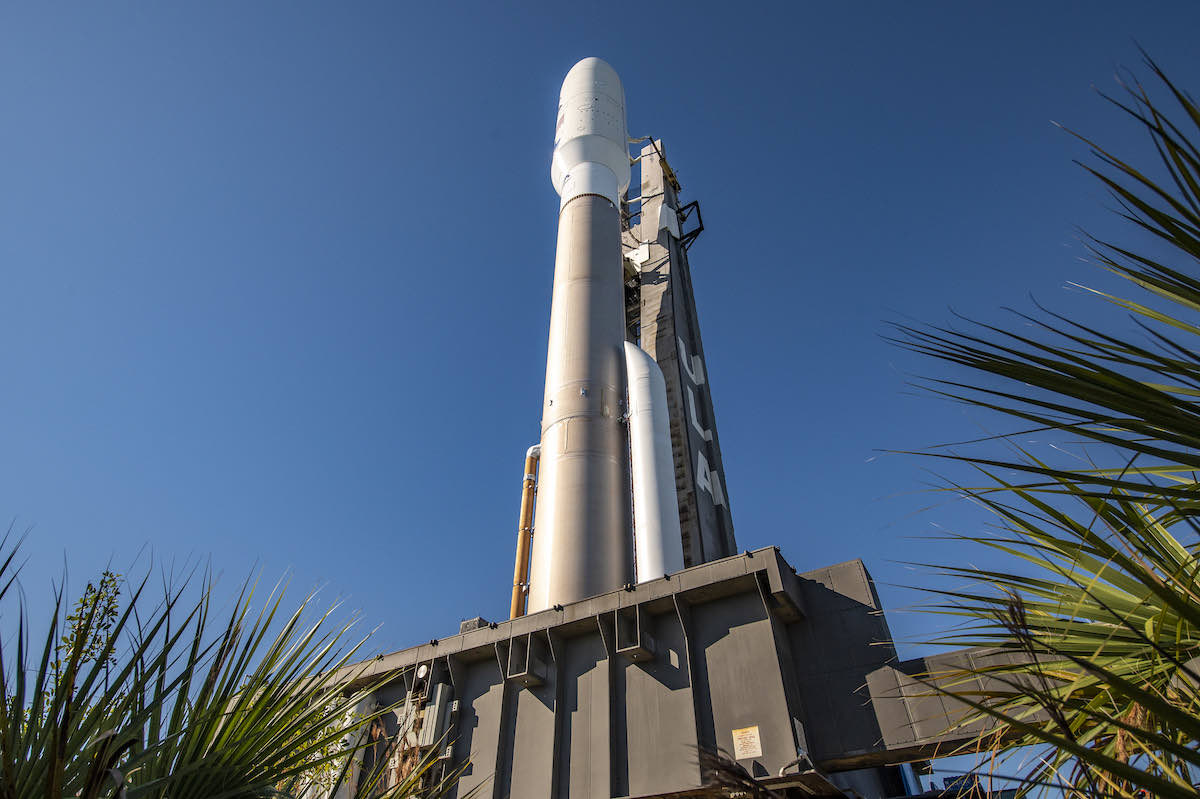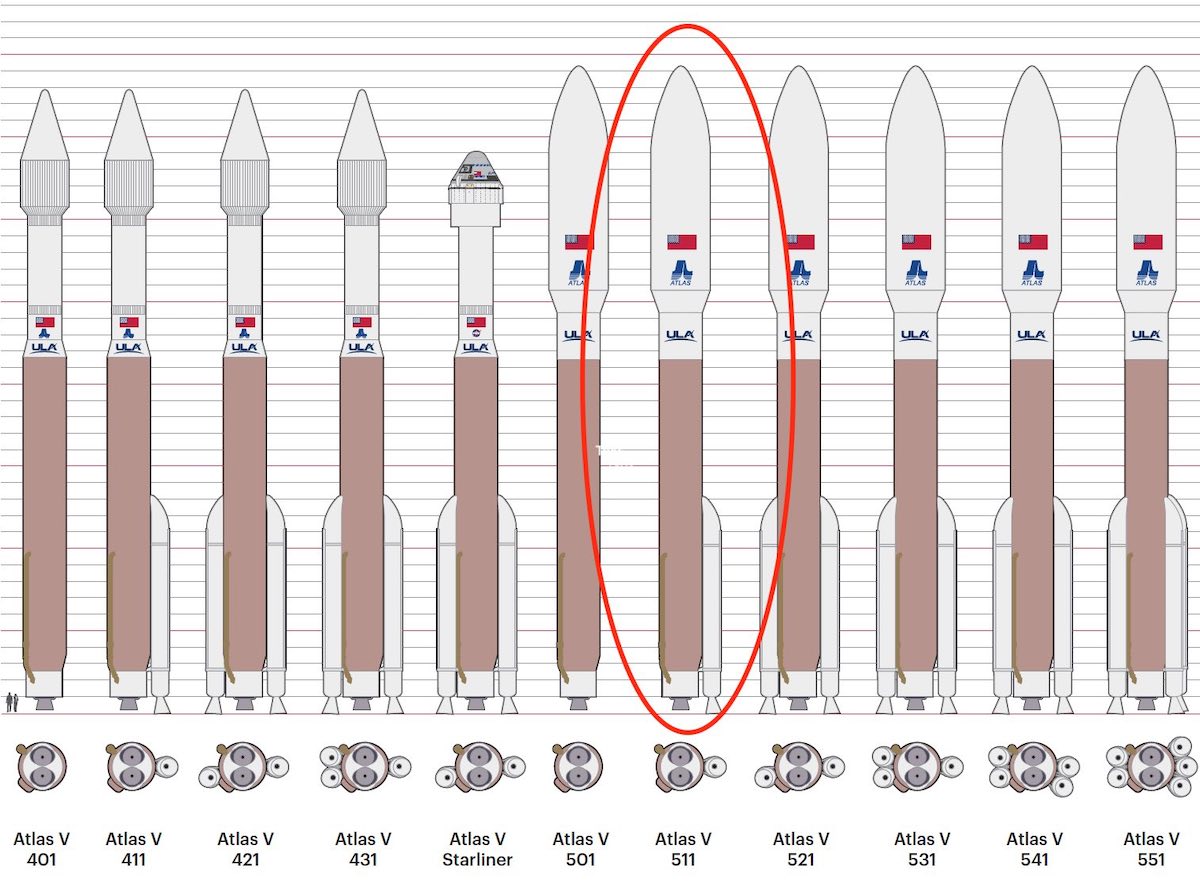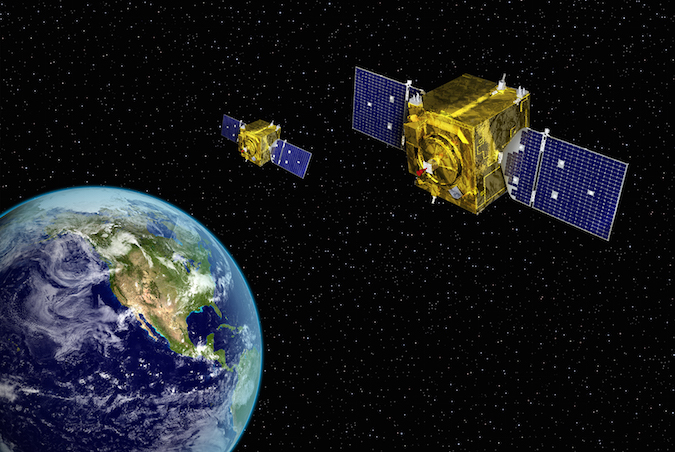
United Launch Alliance’s Atlas 5 rocket has flown in 10 different configurations over 90 missions since 2002, each version optimized to haul satellites of a certain size and mass into space.
The only variant of the Atlas 5 rocket yet to fly is set to launch Friday afternoon from Cape Canaveral with a pair of satellites to help the U.S. military keep track of traffic in geosynchronous orbit.
Fitted with a single solid rocket booster to provide an extra burst of speed off the launch pad, the Atlas 5 is set to depart Cape Canaveral Space Force Station at 2 p.m. EST (1900 GMT) Friday to begin ULA’s first mission of 2022.
The mission: Deliver the fifth and sixth satellites to orbit for the Space Force’s Geosynchronous Space Situational Awareness Program.
The GSSAP satellites are designed to help the military track and observe objects in geosynchronous orbit more than 22,000 miles (nearly 36,000 kilometers) over the equator. The first four GSSAP satellites launched in pairs on Delta 4 rockets in 2014 and 2016.
In 2017, the military confirmed it ordered two additional GSSAP satellites from Orbital ATK, now part of Northrop Grumman. Those satellites, each the size of a compact car, are mounted side by side inside the Atlas 5 rocket’s payload fairing for launch Friday.
ULA will use a unique configuration of its workhorse Atlas 5 launcher for the mission, which the Space Force has designated USSF 8.
The Atlas 5 will be fitted with a single strap-on solid rocket booster supplied by Northrop Grumman, a 5.4-meter (17.7-foot) diameter payload fairing provided by RUAG Space, and a single RL10 engine from Aerojet Rocketdyne on the rocket’s Centaur upper stage.
This version of the Atlas 5 is known as the “511” configuration, with the first number denoting the size of the payload fairing, the second number representing the number of solid rocket booster, and the third digit the number of engines on the Centaur stage.
The placement of just one strap-on booster on the side of the Atlas 5’s first stage will give the rocket asymmetrical thrust as it climbs off the pad. Atlas 5 missions have flown with a single solid rocket booster before, but those flights used the smaller 4-meter-wide payload fairing option.
The Atlas 5-511 rocket will take off with 1.2 million pounds of thrust from the single solid-fueled booster and the first stage’s kerosene-fueled RD-180 main engine. According to ULA, the Atlas 5-511 can carry up to 11,570 pounds (5,250 kilograms) to an elliptical geostationary transfer orbit. Its capacity to low Earth orbit is roughly 24,250 pounds (11,000 kilograms), according to ULA performance data.

Tory Bruno, ULA’s CEO, calls the “511” version of the Atlas 5 the “Big Slider.” Its launch Friday will likely be the only flight of the Atlas 5-511 configuration.
“We call it the ‘Big Slider’ because if you watch the launch, you’re going to see it kind of power slide off the pad because of this asymmetric torque,” Bruno said in a video posted on YouTube by ULA. “A lot of you wonder how do you fly that. That nozzle (of the solid rocket booster) is canted to pass through the average center of gravity, and the RD-180 has tremendous control authority with its thrust vector system, and it can overcome that and compensate for it, and this is just the right amount of energy to carry these two payloads to their very cool mission of space surveillance.”
The Atlas 5 rocket was designed by Lockheed Martin to fly in up to 20 different configurations, giving engineers the ability to “dial” the rocket’s power and payload volume to meet the needs of each specific mission. Mission planners have the option of flying a four-meter or five-meter diameter payload fairing, and can fly the Atlas 5 with up to five strap-on solid boosters, or none if the mission doesn’t need them.
The Atlas 5’s Centaur upper stage can fly with one or two RL10 engines, depending on mission requirements. So far, all but one Atlas 5 launch has flown with the single-engine Centaur upper stage.
The exception is on launches with Boeing’s Starliner capsule, which launches with a dual-engine Centaur stage. There are no other missions on the Atlas 5 launch schedule confirmed to use the dual-engine Centaur stage.
The addition of the unique Atlas 5 configuration for Starliner missions and the lack of use of other dual-engine Centaur variants effectively leaves 11 Atlas 5 versions that will have flown at least once before the rocket’s retirement.
Lockheed Martin merged its Atlas rocket program with Boeing’s Delta family in 2006 to create United Launch Alliance.
The most-used version of the Atlas 5 to date is the “401” variant with a four-meter fairing and no solid boosters. The Atlas 5-401 has flown 40 times, including the first Atlas flight in 2002.
There have been six flights of the Atlas 5-411 configuration with a sole solid booster.
With asymmetrical thrust countered by steering from the Atlas 5’s RD-180 main engine, the Atlas 5-511 and -411 configurations are unique among launchers currently in service. The ability to add a single booster allows customers to pay for just enough capacity for their payloads, rather than buying a more larger, more expensive Atlas 5 variant.
ULA is developing the upgraded Vulcan Centaur rocket to replace the Atlas and Delta rocket families.
There are 26 more Atlas 5 rockets remaining in ULA’s inventory, including the launch vehicle awaiting liftoff Friday afternoon. All have been allocated to future missions for the Space Force, NASA, and Amazon’s Kuiper internet satellite constellation.
There are just three Delta rockets left to fly, and all are assigned to carry classified cargo into orbit for the National Reconnaissance Office, the U.S. government’s spy satellite agency.
ULA’s ground crew at Cape Canaveral transferred the 196-foot-tall (59.7-meter) Atlas 5 rocket from the company’s Vertical Integration Facility to launch pad 41 Thursday. Technicians began stacking the Atlas 5 inside the vertical hangar Dec. 18 with the lifting of the first stage, followed by attachment of the solid rocket booster, the Centaur upper stage, and finally the GSSAP 5 and 6 satellites inside their payload shroud Jan. 10.
The 1,800-foot (550-meter) rollout took about an hour Thursday morning. After the rocket’s arrival at the launch pad, teams started loading rocket-grade kerosene fuel into the Atlas 5’s first stage.
The launch day countdown will begin seven hours before liftoff, and the Atlas 5 will be loaded with cryogenic liquid hydrogen and liquid oxygen propellants beginning around 12 p.m. EST (1700 GMT) Friday. The hydrogen and oxygen will feed the Centaur upper stage’s RL10 engine, while the oxygen will be consumed by the first stage’s RD-180 main engine in combination with kerosene fuel.
After a final readiness check at T-4 minutes, the Atlas 5 countdown will resume from a built-in hold to target launch at 2 p.m. EST.
The RD-180 engine will flash to life at T-minus 2.7 seconds. Moments later, the single solid rocket booster will ignite and send the Atlas 5 downrange on course due east from Cape Canaveral over the Atlantic Ocean.

The rocket will exceed the speed of sound in 58 seconds, and the strap-on booster will burn its pre-packed fuel supply before its release from the Atlas 5’s first stage at T+plus 2 minutes.
The payload fairing will jettison at T+plus 3 minutes, 30 seconds, followed by shutdown of the RD-180 first stage engine at T+plus 4 minutes, 21 seconds. Six seconds later, the Atlas 5’s first stage will separate to clear the way for ignition of the Centaur stage’s RL10 engine at T+plus 4 minutes, 37 seconds, for an eight-and-a-half minute burn.
After reaching a parking orbit with the twin GSSAP satellites, the Centaur stage will coast most of the way around the world before reigniting its RL10 engine for a four-minute burn over the Pacific Ocean northeast of Australia. That will send the upper stage and the GSSAP satellites into an elongated transfer orbit stretching as far as 22,000 miles (nearly 36,000 kilometers) from Earth.
A final burn of the RL10 engine, lasting nearly two minutes, is scheduled six-and-a-half hours into the mission, once the rocket reaches the proper altitude for deployment of the two GSSAP spacecraft. The two satellites will separate one at a time at T+plus 6 hours, 35 minutes, and T+plus 6 hours, 45 minutes.
The GSSAP satellites will unfurl their solar panels and contact ground stations, allowing military personnel to confirm each spacecraft’s health and status following launch. After a period of checkouts and commissioning, the satellites will enter operational service for the Space Force.
The GSSAP satellites lurk near the ring of geosynchronous satellites that fly around Earth at the same speed of the planet’s rotation, allowing craft to remain over a fixed geographic location. Commercial companies and defense agencies use the orbit for communications, missile warning and signals intelligence missions.
Not only can the surveillance platforms help the Air Force track objects in geosynchronous orbit — a capability needed to manage traffic and avoid collisions — the GSSAP spacecraft can adjust their orbits to approach and image other satellites using sharp-eyed optical cameras.
The GSSAP satellites’ ability to maneuver around other spacecraft gives military officials data on the location, orbit and size of other objects in geosynchronous orbit, according to the Space Force, “enabling characterization for anomaly resolution and enhanced surveillance, while maintaining flight safety.”
“Data from GSSAP uniquely contributes to timely and accurate orbital predictions, enhancing our knowledge of the geosynchronous orbit environment, and further enabling space flight safety to include satellite collision avoidance,” officials wrote in the Space Force’s official GSSAP fact sheet.
The GSSAP program, which was classified until 2014, produces data that helps military and other government satellites “navigate freely and safely” in geosynchronous orbit, according to the Space Force’s Space Systems Command.
“The first four GSSAP satellites have performed remarkably well,” said Lt. Gen. Stephen Whiting, commander of Space Operations Command. “These next two satellites will add to that capability and enable us to understand more completely things that occur in the geosynchronous orbit. It’s a key piece in the puzzle for space domain awareness.”
“The way I describe it is a neighborhood watch capability,” said Gen. John “Jay’ Raymond, the chief of space operations and the highest-ranking officer in the Space Force. “It allows us to better understand what’s going on in the domain, especially in a really critical orbit like geosynchronous orbit.”

The Air Force sent one of the GSSAP satellites to the aid of a crippled U.S. Navy communications satellite in 2016. The Navy’s fifth MUOS relay satellite ran into propulsion trouble after launch, forcing it to use backup thrusters to climb into its perch in geosynchronous orbit.
The GSSAP satellite changed course to capture imagery of the MUOS 5 spacecraft to give engineers insight into its status and condition, the Air Force said.
“Historically, the way we have surveilled or had awareness of the domain is we’ve taken observations from radars or optical capabilities, and we’ve come up with an address in space, if you will, of objects,” Raymond said Tuesday in a virtual discussion hosted by the Mitchell Institute.
Cataloguing satellites and space debris has been the a chief goal of the military’s space-related efforts for decades. But with countries like China and Russia fielding increasingly sophisticated military spacecraft, including anti-satellite capabilities, the Space Force needs the GSSAP satellites to add a new dimension in its tracking of objects in orbit.
“We’ve been worried about making sure two things don’t collide, that we can keep that domain safe for all, which is critical. But it’s not sufficient,” Raymond said. “If you move into a war fighting domain, you have to have more knowledge than just where something is. You have to have some insights into what those capabilities are, and this neighborhood watch capability has provided us a fuller look at what’s in space, specifically in the geosynchronous domain.”
The fifth and six satellites will provide “additional capacity” for the GSSAP network to better cover the large volume of space in the geosynchronous belt, Raymond said in response to questions from Spaceflight Now.
Email the author.
Follow Stephen Clark on Twitter: @StephenClark1.
